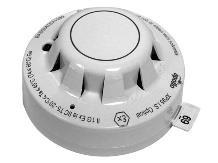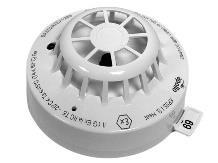Optical Smoke
The XP95 I.S. Optical Smoke Detector uses the light scatter principle to quickly and effectively detect a range of slow burning and smoldering fires in explosive areas.

- Reliable fire detection in areas with a wide temperature range from -20°C to +60°C
- Incorporates an IR (infrared) LED and photo diode
- Ideal for slow burning or smoldering fires (particles >.3 microns)
- Multiple sensitivity settings
- Unaffected by wind and atmospheric pressure
- Insect resistant screen
- Model 55000-640APO
Heat
The XP95 I.S. Heat Detector is distinguishable from XP95 I.S. smoke detectors by its low air-flow resistance case which allows good contact between the sensing thermistor and the surrounding air.

- Incorporates a single open-air thermistor bead
- Multiple sensitivity settings
- Model 55000-440APO
Flame
The Conventional I.S. Flame Detector (IR3) is designed for harsh environments in either indoor or outdoor applications. It is sensitive to low frequency flickering IR radiation emitted from flames during combustion. The sensor operates even through a layer of oil, dust, water vapor, or ice.
- ATEX & IECEx certified: II 1 G
- CENELEC/IEC Certified: Ga Ex ia IIC T4
- Class 1 sensitivity to EN 54-10 detects 0.1m2 fire at 25m
- High optical interference immunity
- Selectable response speed
- Optical self test
- Low power consumption
- Model 55000-063APO
Ionization Smoke
The XP95 I.S. ionization smoke detector has a molded self-extinguishing white polycarbonate case with wind resistant smoke inlets. It uses an Americium 241 radioactive source mounted within the inner reference chamber to irradiate the air and detect changes in levels of smoke.

- Ideal for fast burning, high energy, flaming fires (particles <0.01 microns)
- Multiple sensitivity settings
- Model 55000-540APO
Intrinsically Safe SLC Interface Module
The Intrinsically Safe (IS) SLC Interface Module is the bridge between an SLC loop (or bus) in a safe area and a stub of IS detectors in an explosive area. The device contains the following main components:
- SLC isolator for short circuit isolation on the safe side of the bridge,
- SLC bus voltage level shifter to translate the SLC bus signals between the typical SLC levels and maximum safe levels for the IS area, and
- IS barrier to limit the energy that can enter the IS area.
The design and construction of the IS SLC Interface Module allows it to be installed in accordance with intrinsically safe devices as defined in National Electrical Code NFPA 70.
The figure below shows the typical topology associated with use of the interface.




